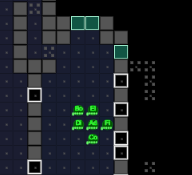Chernobyl Simulation: Part 1

The worst nuclear disaster of the 20th century was the Chernobyl accident. Here's a simuation of the reactor.
Simulation 1: Normal running of the reactor.
List of things in the simulation:| Part | Function | Controls |
|---|---|---|
| Reactor | This contains fissionable materials that generate neutrons. The neutrons are shown by blue sparks. A side effect of the reaction is that the reactor heats up when running. | |
| Control Rods: Manual | These are rods made of a material that absorbs neutrons. When inserted, they slow or stop the reaction. | "rod 0" --- take the control rods all the way out. "rod 0.56" --- control rods 56% in. "rod 1" --- control rods all the way in. |
| Control Rods: Automatic | Some of the rods are automatic. They are moved up or down to target a certain power. | "target 300" --- The rods will move to try to achieve 300 MW. However, they can only affect the reaction so much: Once they're out of the reactor, they can't further increase the power. Likewise, once they're fully inserted, they can't further decrease power. |
| Cooling System | The reactor needs water. Water cools the reactor, and it also absorbs some neutrons, helping to control the reaction. Without enough cool water, steam builds up in the reactor, increasing the reaction. |
"cool 0" --- reduce cooling flow to zero. "cool 1" --- maximum cooling. |
| Steam Separator | A big tank receives steam and water from the reactor. Steam is sent to the generator. It comes back as cooler water. Excess water is then sent back to the reactor as coolant. | |
| Generator and Coolant | Steam is used to drive the turbine, before being cooled and pumped back into the steam separator. It might seem weird to use the high pressure steam to drive a generator, and then pump it back, but because the steam has a lot more volume than the colder water, this process generates energy. |
cold 0 --- stop the pump that pumps cold water back to the steam separator. cold 1 --- restart it. |
| Emergency Core Cooling System | There's a large reservoir of water that can be pumped into the reactor if the need arises. In this simulation, the ECCS pump is used to regulate the reactor pressure. I think in the real reactor, pressure regulation is done using different systems. |
"eccs on" --- switch the ECCS system on. "eccs off" --- switch it off. "extra 0" --- switch the pump off. If the ECCS is on, this will reduce the pressure of the reactor. |
The simulation
The reactor is running at about 500MW at the moment. Type things in to the console below the simulation to control the simulation. Press enter to submit command.You can progress to the next step once you've manage to keep the reactor producing between 3400 MW and 3600 MW for 10 seconds.
By the way, here are some limitations of the simulation:
- The simulation is not that accurate.
- The simulation parameters were fit by playing around with it until the accident was similar to wikipedia and a few other technical documents. This makes it more descriptive than predictive.
- Not every aspect of the accident could be replicated- probably because the simulation is too simplistic.
- The system in the simulation is simpler than the real reactor.
Part 2
This is just the first part of the simulation. To go to part 2, complete the challenge above, or go here if you want to cheat.Other Articles:

|
Physics Algorithms BookThis is a work in progress to write a book on physics algorithms. At the moment, it is about 1/3 finished though, but the latest version can be downloaded for free. |

|
Experimental Flying GameFly around in a plane. Some physics, but mainly just playing with websockets. If you can get a friend to play at the same time, you should be able to shoot each other down. |
AsciishipMy latest (early 2018) thing is just a "normal" game: no real physics. It's just a game. |

|
© Hugo2015. Session @sessionNumber